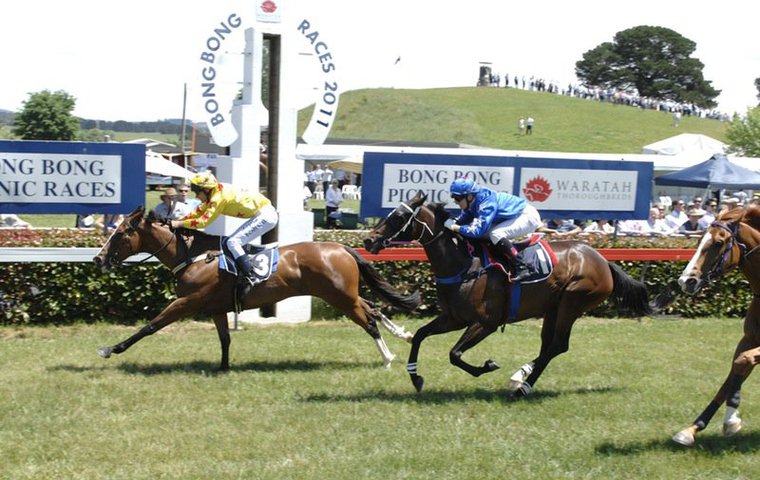
Turning up to the races in a suit and tie can draw strange looks on the picnic racing circuit in Australia. Casual shirts, shorts, leisurely footwear, a hat and plenty of sunscreen is all that is needed to enjoy a great day at one of the hundreds of picnics meetings held in Australia each year.
Picnic, or amateur racing, as it would be better known overseas, has been part of not only the Australian racing scene but the nation’s culture for more 150 years. Dubbed ‘picnic racing’ because many of the tracks were in provincial or country areas, ‘picnic’ meant exactly that, with patrons encouraged to bring their own own food and drink to enjoy, as well as a day’s racing and socialising.
Sadly, the drinking side of things caused the demise of the nation’s biggest picnic meeting at Bong Bong, near Bowral in the Southern Highlands of New South Wales, about 125km, or a 90-minute drive, south of Sydney.
The Bong Bong Picnic Race Club had enjoyed one resurrection after a 30-year hiatus in 1959, but disgraceful behaviour from a drunken section of the 35,000 people the event had grown to attract by the mid-1980s prompted the Australian Jockey Club, who ran NSW racing at the time, to strip the club of its right to hold meetings.
Booze-fuelled escapades
The state and local governments also took a dim view of the events, which culminated with mobs continuing their booze-fuelled escapades in the streets of Bowral.
To put it into context, a 35,000 crowd at an Australian race meeting was amazing in the days of declining attendances and is more than attended the Caulfield Cup and Cox Plate meetings in October last year, so it is little wonder the sheer weight of people stretched the facilities and the manpower available at the time.
The Bong Bong Picnic Race Club received permission to operate meetings again in 1992 under the strictest of conditions imposed by the state and local governments. Only members and their guests were allowed to attend, with no patrons to bring their own liquor to the course, while meetings could only be conducted on weekdays.
Such conditions explained the visible police presence, which was one of the first things I noticed when I arrived at the circuit for the club’s latest Bong Bong Cup day last month.
Remarkable experience
The restricted crowd made moving around to explore the circuit rather comfortable, but the best way to watch the races was atop the significant hill in the centre of the track. The hill, reaching perhaps 25 or 30 metres high, prevents those in the usual viewing places on the track from seeing the entire race, but watching a race from the top of the hill is a remarkable experience with views of the nearby paddocks stretching for a good distance.
James Cummings, the grandson of the late Australian training legend Bart Cummings, claimed his second successive edition of the $35,000 Bong Bong Cup with Alfred The Great after scoring with Colour Of Money in 2015, but the day itself is a wonderful example of the Australian tradition of heading to a country race meeting.
Picnic racing is in great shape all around Australia, stretching from a thriving circuit in the eastern half of Victoria at places such as Healsville, Yea and Balnarring to the other side of the country, where the Toodyay Race Club has held meetings since 1865, beginning racing a mere four years after the first Melbourne Cup. Courses in distant places, well away from Australian capital cities, have raced for more than a century.
Benefitting the local economy
But picnic racing is more than just an excuse to head to a racetrack for beer, wine and/or a bet. The courses provide immeasurable benefits to the economy of their areas. Nearby traders or sporting associations, which are quite often the lifeblood of Australian communities, operate food and drink stalls, hold raffles and genuinely need the sales from the attendees at the meetings or the fundraising opportunities the meetings produce to survive.
Victorian picnic meetings alone attracted more than 59,000 people to 31 meetings, with betting turnover coming in above the $3 million mark for the season. On-course food and beverage sales directly benefit the local communities, adding to the huge financial interest in picnic races, which almost always attract the lowest classes of horse to compete for prize money that seldom gets over $5,000 per race.
While the racing is different, much different from the competition on the pristine grass tracks of Flemington, Ascot or Sha Tin, picnic racing offers a wonderful racing experience. It offers the chance to enjoy the sport at a much slower pace, more akin to the times before racing developed into the seven-day a week product churn that the game has become in Australia.
Sometimes slowing down is just what racing needs.


